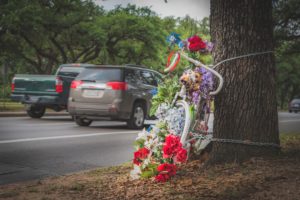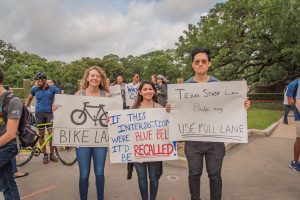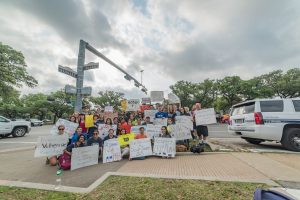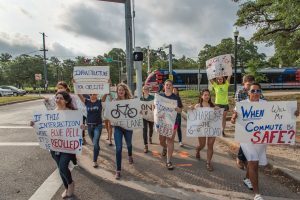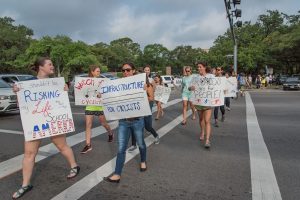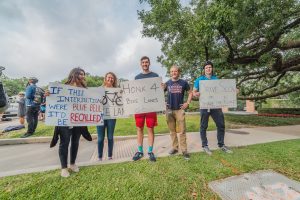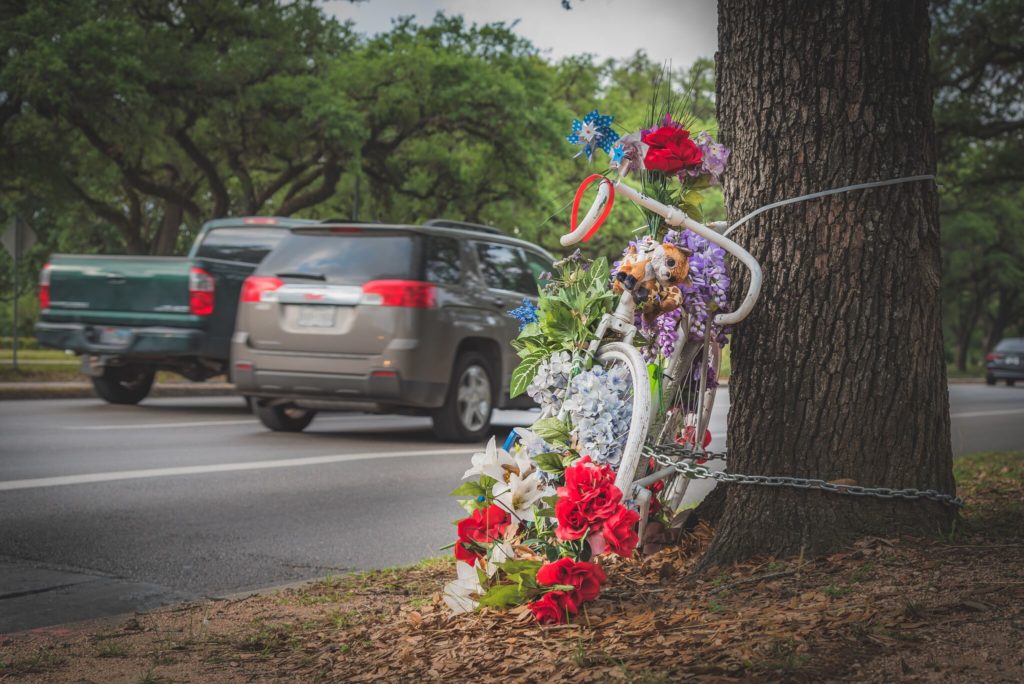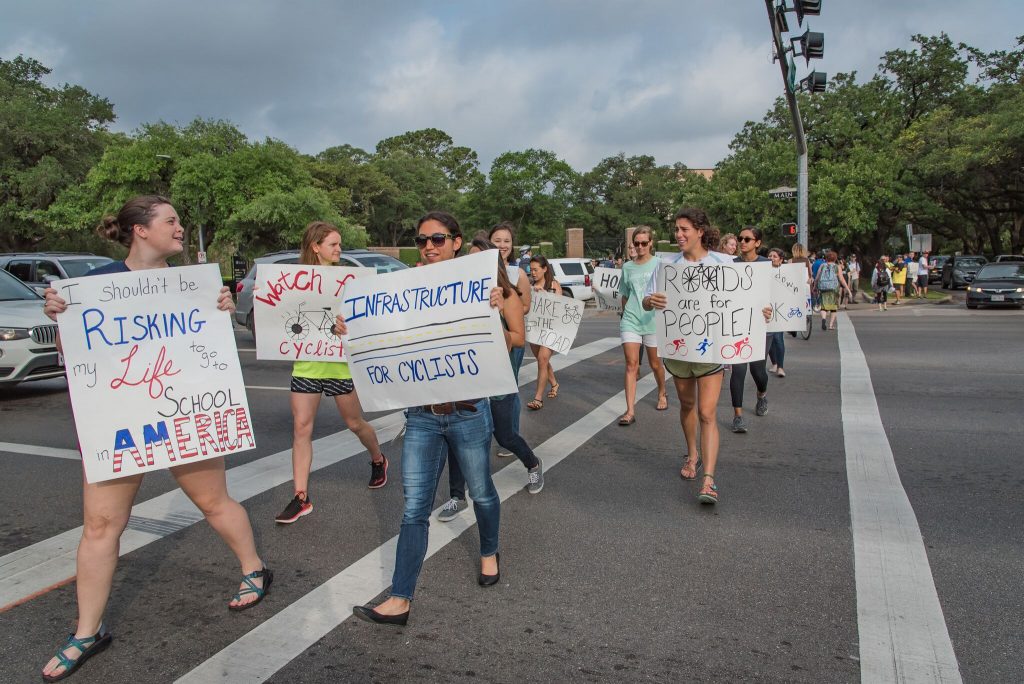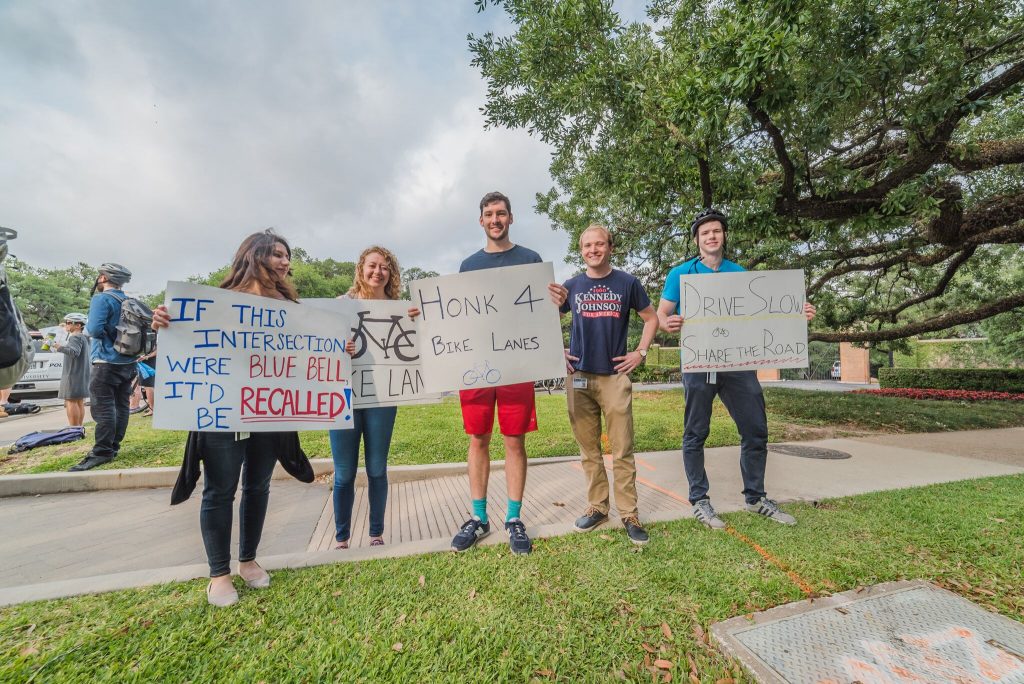Bike Deaths Have Rice University Students Taking a Stand Against Deadly Intersection: Delayed Action, Aggressive Drivers and METRO Trains a Toxic Mix
BY Annie Gallay //Two recent bike deaths at the same intersection spurred protests and calls for change.
Is a deadly intersection making Rice University unsafe? That’s what a vocal group of students believe and they’re taking a stand in the wake of two bicyclists being killed at the corner of Sunset and Main. The students argue that there is simply no safe side when it comes to this corner.
There have been two Rice cyclist fatalities in just over a year at the crossing outside the front gates of the university. Accidents at that perilous corner claimed the lives of Rice professor Marjorie Corcoran on February 3, 2017 and Sudipta Roy, a nurse and the wife of a Rice professor, on April 24.
Or maybe “accident” isn’t the right word. “This is a crash, not an accident. Crashes that happen repeatedly in the same area aren’t accidents, they are preventable and require design changes,” BikeHouston, a nonprofit dedicated to creating safe bikeways in the city, declared in a statement following the death of Roy.
The Rice University community recently banded together on Sunset and Main to speak out against the bike deaths and the glaring dangers facing cyclists. Rice Graduate student and president of the Rice Cycling and Triathlon Club, Mary Natoli, arranged the demonstration.
The message? Enough is enough.
Signs ran the gamut from imploring to lighthearted, as students tried to use gallows humor to get the message across. “Let’s look out for each other,” one read. “When will my commute be safe?” read another. “If this crosswalk were Blue Bell, it would have been recalled,” another sign blared.
Seventy five people, primarily Rice students, gathered together for an hour to protest what they feel is the City of Houston’s failure to act. “Last year after Dr. Corcoran was killed, METRO hired an outside safety consultant to evaluate the intersection. Roadway design changes including bike improvements were among the recommendations, but those changes have not been implemented by the City of Houston,” BikeHouston said in its statement. Fourteen months later, and no change.
The intersection is one of the busiest in the area, bridging the university with the Museum District and Hermann Park. “Over 1,100 members of the Rice community travel to the university by bike, and they are currently not safe in doing so,” Natoli tells PaperCity.
Corcoran was struck by a crossing light rail train as she biked over a set of tracks along Fannin and Sunset. Roy was hit by a dump truck as she crossed Sunset and Main. She had just left a lunch date with her husband at Rice.
After the crash, the Houston Police Department’s accident report determined that Roy was at fault because she should have used the road, not the crosswalk. Signage at Hermann Park indicates that pedestrians and cyclists should use the crosswalk, Natoli notes.
The Rice community is still recovering from the loss of Roy and Corcoran. “I was heartbroken. I make that crossing on my bike every day, and despite being as visible as possible and a very cautious cyclist, I have had enough close calls at that location to know it could have easily been me,” Natoli says.
Biking Fear — and Ugly Motorists
Change can’t come fast enough, especially to those still living in fear nearly two weeks after the latest death. “I am still full of fear and anxiety when I cross the intersections there, to this date,” Natoli says.
Fellow Rice graduate student Cat Majors shares her anxiety, and had an extremely close call herself. “I used to bike to campus daily. I was hit by a car several years ago on the corner of Main and University,” she says. Although Majors made it without injury, it took her more than a year to feel safe biking again.
“I rarely use my bike to commute, even now, because drivers in the Med Center area are simply too aggressive and viability is low,” she says.
Majors considers herself an aware cyclist, taking bike safety seriously, holding her line, frequently checking to see if there are cars around her and signaling any time she changes lanes or turns.
“Despite all this, I frequently have drivers yell at me and tell me to get off the road, often while passing incredibly close to me,” she says. “Drivers in Houston — not all, but many— don’t seem to understand that cyclists do belong on the road, and they need to share.” Natoli agrees, saying that some motorists even intentionally drive aggressively when they see a biker.
The lack of sharing the road comes at a high toll. “The sadness is punctuated with outrage and frustration because this could have been prevented,” Natoli says. The problem isn’t unsolvable, Majors adds. “With education and proper infrastructure, I think drivers can learn how to interact safely with cyclists and pedestrians.”
City spokeswoman Alanna Reed addressed the issue at a City Council meeting last week. “After Dr. Marjorie Corcoran’s fatal accident last year at the Sunset and Fannin intersection, changes were already in design by METRO,” Reed said. She also noted that the city had teamed up with Houston METRO to develop improvements. One such plan would prevent eastbound traffic on Fannin by directing drivers to Main.
“The city has approved a conceptual design and construction will begin upon approval of the final design,” Reed says.
Majors has seen some improvements by the Fannin side of the street, where METRO has put up new signage and the rails now honk upon approach. It’s not enough. “I would like to see yield to bikes and pedestrians’ signs, more visible bike lanes, and potential changes to the timing of the lights to make the intersection safer for all users,” she says.
Now, it’s up to city and METRO officials to follow through. “The sole responsibility for survival cannot be placed on an unprotected, vulnerable cyclist or pedestrian when a driver is controlling a half-ton piece of equipment, hurtling down the road at 1 to 2 times our speed,” Majors says.
